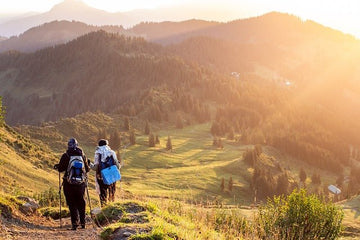Vorbereitung auf eine Wanderung: Ein Leitfaden für Anfänger zur Grundausrüstung und Sicherheit
von {{ author }} Emily Jannet an Aug 05, 2024
Ein Wanderabenteuer kann ein aufregendes Erlebnis sein, bei dem man die Natur kennenlernt, seine körperlichen Grenzen austestet und dem Alltagsstress entflieht. Für Anfänger ist die richtige Vorbereitung entscheidend, um Sicherheit und Spaß auf der Wanderung zu gewährleisten. In diesem Leitfaden geht es um wichtige Dinge wie einen Notfallponcho, einen Feueranzünder und andere Accessoires, die Ihnen bei der Vorbereitung auf Ihre erste Wanderung helfen.
1. Planen Sie Ihre Wanderung
Informieren Sie sich vor der Abreise über den Weg, den Sie wandern möchten. Beachten Sie Folgendes:
- Schwierigkeitsgrad und Länge des Wanderwegs: Wählen Sie einen Wanderweg, der Ihrem Fitnesslevel und Ihrer Erfahrung entspricht. Anfänger sollten mit kürzeren, gut markierten Wanderwegen beginnen.
- Wetterbedingungen: Überprüfen Sie den Wetterbericht, um die Bedingungen vorherzusehen. Dies beeinflusst Ihre Kleidungs- und Ausrüstungsauswahl.
- Wegbestimmungen und Genehmigungen: Für manche Wege sind Genehmigungen erforderlich oder es gelten besondere Bestimmungen. Stellen Sie sicher, dass Sie diese einhalten, um Bußgelder zu vermeiden und Ihre Sicherheit zu gewährleisten.
2. Kleidung und Schuhe
Das Tragen der richtigen Kleidung und des richtigen Schuhwerks ist für Komfort und Schutz von entscheidender Bedeutung:
- Kleidung in mehreren Schichten: Wenn Sie sich in mehreren Schichten kleiden, können Sie sich an wechselnde Temperaturen anpassen. Beginnen Sie mit einer feuchtigkeitsableitenden Basisschicht, fügen Sie eine isolierende Schicht hinzu und runden Sie das Ganze mit einer wasser- und winddichten Außenschicht ab.
- Festes Schuhwerk: Investieren Sie in ein Paar Wanderstiefel oder -schuhe mit guter Knöchelunterstützung und Halt. Laufen Sie sie vor Ihrer Wanderung ein, um Blasen zu vermeiden.
- Socken: Tragen Sie feuchtigkeitsableitende Socken, um Ihre Füße trocken zu halten und Blasen vorzubeugen.
3. Grundausstattung
Neben der Kleidung gibt es wichtige Dinge, die jeder Wanderer bei sich tragen sollte:
Rucksack
Wählen Sie einen bequemen, gut sitzenden Rucksack, um alles Wichtige zu transportieren. Achten Sie auf gepolsterte Träger und einen Hüftgurt, um das Gewicht gleichmäßig zu verteilen.
Das Wetter kann unvorhersehbar sein und Nässe kann selbst bei milden Temperaturen zu Unterkühlung führen. Ein Notfallponcho ist eine leichte, kompakte Lösung, die sofortigen Schutz vor Regen bietet. Bewahren Sie ihn an einem leicht zugänglichen Ort in Ihrem Rucksack auf. Ponchos können auch als Bodenabdeckung oder provisorischer Unterschlupf dienen.
Ein Feueranzünder aus Feuerstein und Stahl ist ein wichtiges Werkzeug in Überlebenssituationen. Er ermöglicht es Ihnen, ein Feuer zu entzünden, um sich zu wärmen, zu kochen oder um Hilfe zu signalisieren. Es gibt verschiedene Arten von Feueranzündern, darunter:
- Ferroceriumstäbe: Diese erzeugen Funken, wenn sie mit einem Metallschaber angeschlagen werden. Sie sind zuverlässig und funktionieren auch bei Nässe.
- Wasserfeste Streichhölzer: Diese sind so behandelt, dass sie auch bei Feuchtigkeit brennen. Bewahren Sie sie in einem wasserfesten Behälter auf.
- Feueranzünderwürfel oder -stäbchen: Diese lassen sich leicht entzünden und können dabei helfen, schnell ein Feuer zu entfachen.
Navigationstools
Tragen Sie immer eine Karte und einen Kompass bei sich, auch wenn Sie ein GPS-Gerät oder ein Smartphone haben. Elektronische Geräte können ausfallen, Karte und Kompass jedoch nicht. Lernen Sie, wie man sie benutzt, bevor Sie sich auf den Weg machen.
Flüssigkeitszufuhr und Ernährung
- Wasser: Nehmen Sie für die Dauer Ihrer Wanderung ausreichend Wasser mit. Eine gute Faustregel ist, mindestens einen Liter Wasser pro zwei Stunden Wanderung mitzunehmen. Erwägen Sie die Verwendung einer Trinkblase für einfachen Zugriff.
- Wasseraufbereitung: Wenn Ihre Wanderung lang ist oder es auf dem Weg Wasserquellen gibt, nehmen Sie einen Wasserfilter oder Reinigungstabletten mit.
- Essen: Packen Sie energiereiche Snacks wie Studentenfutter, Energieriegel und Trockenfrüchte ein. Nehmen Sie für längere Wanderungen leichte, nährstoffreiche Mahlzeiten mit.
Erste-Hilfe-Kasten
Ein grundlegendes Erste-Hilfe-Set sollte Heftpflaster, antiseptische Tücher, Mittel zur Blasenbehandlung, Schmerzmittel und persönliche Medikamente enthalten. Passen Sie Ihr Set an die Besonderheiten Ihrer Wanderung und Gruppengröße an.
Multifunktionswerkzeug oder Messer
Ein Multifunktionswerkzeug oder Messer kann für Aufgaben wie das Durchschneiden von Seilen, die Zubereitung von Speisen oder die Durchführung von Notfallreparaturen von unschätzbarem Wert sein.
Beleuchtung
Nehmen Sie eine Stirnlampe oder Taschenlampe mit Ersatzbatterien mit. Auch wenn Sie Ihre Wanderung vor Einbruch der Dunkelheit beenden möchten, kann es zu unvorhergesehenen Verzögerungen kommen.
Eine Pfeife ist ein einfaches, aber wirksames Mittel, um Hilfe zu signalisieren, wenn Sie verloren gehen oder verletzt sind. Drei kurze Töne sind das internationale Notsignal.
4. Sicherheitstipps
- Wandern mit einem Kumpel: Wandern mit einem Begleiter erhöht die Sicherheit und den Spaß. Wenn Sie alleine wandern, informieren Sie jemanden über Ihre Pläne und die voraussichtliche Rückkehrzeit.
- Bleiben Sie auf den markierten Wegen: Wenn Sie von den markierten Wegen abweichen, besteht ein erhöhtes Risiko, dass Sie sich verlaufen oder in gefährliches Gelände geraten.
- Passen Sie Ihr Tempo an: Wandern ist kein Wettrennen. Machen Sie Pausen, trinken Sie ausreichend und hören Sie auf Ihren Körper.
5. Hinterlassen Sie keine Spuren
Respektieren Sie die Natur, indem Sie die „Leave No Trace“-Prinzipien befolgen:
- Müll mitnehmen: Nehmen Sie Ihren gesamten Müll mit.
- Respektieren Sie die Tierwelt: Beobachten Sie Tiere aus der Ferne und füttern Sie sie nicht.
- Bleiben Sie auf den Wegen: Vermeiden Sie Schäden an Vegetation und Boden, indem Sie auf den markierten Wegen bleiben.
Die richtige Vorbereitung kann den Unterschied zwischen einem angenehmen Abenteuer und einer gefährlichen Tortur ausmachen. Wenn Sie sich mit der richtigen Ausrüstung und dem richtigen Wissen ausstatten, können Sie Ihre Wanderreise selbstbewusst antreten. Denken Sie daran, das Ziel ist es, die Natur sicher und verantwortungsbewusst zu genießen. Viel Spaß beim Wandern!







